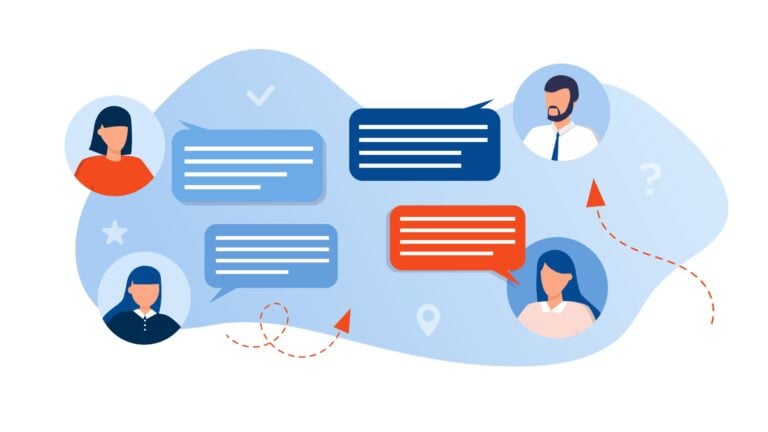Formal communication is more critical than ever as workplace environments become more diverse. Find out how you can use formal communication to improve message delivery within your company.
When you think of communication, you may imagine a casual conversation with a friend or coworker.
However, in many professional settings, formal communication is necessary for effective and organized communication.
So what is formal communication exactly?
What Is Formal Communication?
Formal communication refers to pre-defined channels of communication that are used for official information, orders, and instructions.
It’s when information flows through predefined channels of communication in an organized manner. These channels can be face-to-face horizontal communication between employees on the same level or diagonal communication between employees on different levels.
The goal of formal communication is to ensure that messages are clear and concise and reach the appropriate people in a timely manner.
While formal communication may seem time-consuming compared to informal conversations, it’s essential for businesses to maintain order and structure.
Predefined channels of communication also help establish a clear chain of command so that higher-level employees can give orders or instructions to lower-level employees.
Common forms of formal communication include emails, letters, reports, memos, and presentations.
Formal communication is an essential part of any professional environment as it ensures the flow of information is organized and efficient.
While it can be more structured than informal conversations, predefined channels help establish order within an organization so that everyone can understand their roles and responsibilities clearly.
Formal vs. Informal Communications

The most significant difference between formal and informal communication is the language used. A manager’s email to their team about an upcoming project will contain formal and precise language.
However, that same manager would use more relaxed expressions when sending out congratulations about a team member’s birthday or upcoming retirement.
Below are some other differences between formal vs. informal communication:
- Reliability — Formal communication is seen as more reliable because there’s always a written or electronic record trail.
- Speed — Formal communications travel more slowly as there’s a designated hierarchy around reviewing and approving a communication before making it publicly available.
- Time-consuming — The creation of formal communications takes more time. There may be a need to get through red tape or legal issues with language. Informal communications are often sent immediately with no review.
Key Features of Formal Communication
Let’s explore more details about the common aspects of formal communication.
- Structure — Formal communications in emails and business letters typically follow a set format. There’s usually a header, some common form of greeting, and a signature at the end. Many business people use templates to create memos and other official documents to ensure they communicate official information correctly.
- Language — The language used in professional communications should be precise and appropriate to the context. Slang and other informal phrases should never be used. Formal communications should include proper grammar and no contractions. For example, the writer should spell “do not” instead of “don’t.”
- Tone — The tone of professional communications should remain serious and professional. There should be no personal opinions or emotions apparent in the writing. Instead, the focus should be on conveying accurate information respectfully and objectively. Choose neutral, diplomatic words, especially when touching on sensitive topics.
- Hierarchy — Formal communications should flow through an established company hierarchy. Designated channels should have procedures and protocols in place to govern the flow. No formal communication should go out without prior authorization from a designated company official.
- Documentation — All formal communications should be subject to an archival documentation process that ensures a record of any decisions, policies, or actions taken within an organization. This promotes an environment of accountability and makes information available for future reference.
- Channels of communication — Formal communications should pass through official channels like a designated email system. For example, they can be presented as reports, official letters, or provided to other participants in an organized meeting. Only channels recognized and approved by a company should be used for formal communications.
Pro Tip
A dedicated employee communication tool such as Connecteam can streamline efforts to pass essential information to employees. It will help keep your employees up to date, connected and informed wherever they are through your own communication app.Get started with Connecteam for free today!
Why Is Formal Communication Important?
Formal communication leaves less room for misunderstandings or interpretation errors. If you send a memo that outlines the details of new work policies, employees have something documented to refer to when they have questions.
Relying on informal communication, like a casual conversation over the phone, can lead to misunderstandings that lead to costly and dangerous mistakes.
The strict rules established for different types of formal communications ensure a proper record trail. If a company audit or a legal issue arises, it’s always good to have documentation about what communications occurred and when they happened. That’s a better policy than relying on an employee’s memory or having to contact someone who’s no longer with the company.
Even though it might seem counterintuitive, you can save more time by establishing formal communication. After you’re done writing, you can quickly send it to as many people as you need. That means fewer face-to-face conversations you’d need to have to get the message out to the same number of people.
Pro Tip
A knowledge management base allows you to store information put out in past communications in a single location for employees to locate at their convenience.
What Are the Benefits of Formal Communication?
Formal communication is a vital part of the business process, and its benefits are significant, especially in non-desk industries, where workers might not have continuous access to digital tools or direct face-to-face interaction with management.
Ensuring Safety: Non-desk industries like construction, manufacturing, or logistics often involve potential risks and hazards. Formal communication ensures safety protocols, guidelines, and important updates are clearly communicated, understood, and adhered to by all employees.
Clear Instructions: In industries where workers are out in the field or on the production line, clear and concise formal communication helps to prevent misunderstandings. It ensures tasks are carried out correctly and efficiently, minimizing mistakes and rework.
Maintaining Consistency: Formal communication ensures consistency in delivering messages, especially in industries where employees work in different shifts or locations. This is critical for everyone to be on the same page and to uphold quality standards.
Regulatory Compliance: Formal communication helps maintain records that may be required for regulatory compliance. It helps to demonstrate that employees have been properly informed about policies, procedures, and updates, which is crucial in many non-desk industries.
Reducing Information Gap: Non-desk workers can often feel detached from the core business operations due to the nature of their roles. Formal communication can reduce this gap by providing them with regular updates about company policies, changes, and news, fostering a sense of inclusion.
Accountability: Formal communication helps create a system of accountability in non-desk industries. With written communication, there is a track record of directives given and received, which can be referred back to in case of any disputes.
Feedback Mechanism: Formal communication can also provide a platform for non-desk workers to voice their concerns, ideas, or feedback. This can be invaluable for improving business processes, safety, and worker satisfaction.
Building a Professional Environment: Formal communication promotes a professional work environment and reinforces the company’s authority and hierarchical structure. It sends a message that the organization values its workforce and communicates with them in a respectful and professional manner.
Training and Development: In industries where non-desk jobs are prevalent, formal communication is often used for training and development purposes. It allows companies to share educational materials, guidelines, or procedural updates to ensure workers have the required knowledge and skills.
Types of Formal Communication
Organizations typically distribute formal communications in one of five ways.
Downward Communication
Downward communication involves passing important information through a company from higher management.
Essentially, you’re following a chain of command. For example, a vice president might send a memo informing directors about an upcoming change to PTO policies. Those managers would then pass the information on to members of their team.
Businesses typically use downward communication to send information around:
- Defining new policies
- Outlining changes to existing policies
- Providing information about changes in delegation responsibilities
- Explaining upcoming personnel changes
Downward communication can also happen with informal communications. Instead of sending out an email, a manager might speak with his team face-to-face. However, major reforms should always use the formal communication process to confirm the delivery of the message.
Learn more about Downward Communication: Definition, Benefits, and How to Use It
Upward Communication
Upward communication is the process employees use to provide feedback to management and company leaders. An example would be responding to a yearly survey asking how workers feel about different aspects of the company.
You can also have upward communication occur in a meeting. Typically, employees submit written questions and receive a formal response from management. Many companies also have suggestion boxes or forums where workers can document issues or suggest improvements.
The goal of upward communication is to document employees’ feelings about their work environment. It’s a way for management to get a better sense of the personalities they employ.
The feedback provided by employees allows executives and management to refine processes in ways that help workers become more productive or make employees feel more valued for their contributions.
Horizontal Communication
Horizontal or lateral communication occurs between workers at roughly the same level. They may work in the same department or have similar job titles.
If a site foreman sends a a work-related message to another foreman, that would be an example of horizontal communication.
You often see horizontal communication between team members working on a project. A team member on vacation may document their work processes and pass that on to the person filling in while out.
Horizontal communication is meant to encourage better collaboration and coordination between coworkers.
Diagonal Communication
Diagonal communication encourages direct engagement between workers at different levels and under separate chains of command. Managers might have to pass a formal communication to the field lead of a new project to help them better understand the broader context of their work.
That same field lead might pass updates about the project status to higher-level employees to update them on a project’s progress.
External Communication
External communications describe the formal messages sent from an organization to an external entity. Examples include the legal department responding to an inquiry from a regulatory body. Emails sent to clients and shareholders also count as external communications.
How organizations communicate externally helps establish their image. The format can include everything from web page content to a conference presentation. Any external communications should convey a message of quality and competence about an organization.
Pro Tip
Make it easier for employees to locate others in the organization by implementing a user-friendly employee directory. Dedicated apps like Connecteam help you easily find exactly who you’re looking for and contact them directly from withing the app.
Get started with Connecteam for free today!
Examples of Formal Communication
Let’s take a closer look at how organizations present formal communications.
Meetings
Most employees are familiar with the use of meetings to convey information. Meetings involve both upward and downward communication between a team and management. When it comes to formal communications, structuring an agenda ensures all relevant topics get covered.
Formal meetings typically start with an opening and the introduction of special guests. If you’ve gathered your team into one place, you want to use their time wisely. Stick to your agenda while inviting some level of participation and engagement from the team.
Presentations
Most formal meetings and conference communication include presentations. They’re used to formally communicate ideas, data, or proposals in a professional and structured way.
Presentations should have a clear objective, with the presenter making it clear from the start what they want to convey to the audience.
A presentation can focus on previewing an upcoming product or outlining the purpose of a new company project. Others pass on updates about business initiatives or provide stakeholders with information about a new proposal. Visual aids help enhance a presentation’s message and keep the audience engaged.
Emails
Emails are one of the most common ways to convey messaging throughout organizations.
They’re typically used for the following purposes in formal communications.
- Sending orders and instructions
- Making requests
- Providing official information
- Conveying announcements
Formal emails include a precise and professional subject line that clarifies the message’s intent.
It’s addressed to recipients using formal salutations and closed professionally. The body of the message should contain concise language designed for effective message delivery. Ideally, you want to avoid any flowery or verbose language that detracts from the overall message and use a professional tone throughout.
Memos
Memos convey announcements, new policies, and instructions within an organization. Formal directives can be relevant to a specific department or an entire organization. People typically send memos when there’s a need to distribute sensitive information.
Companies typically keep memos internal to the organization. They’re sent through predefined communication channels to ensure they reach the target audience. For example, memos may only be sent to specific individuals or distribution lists.
Once sent, memos are usually archived to ensure there’s a historical record available around decision-making or policy changes.

Pro Tip
An internal employee communication app with employee survey functionality can provide invaluable insights that show you how well your organization is doing regarding employee communications and engagement.
6 Tips on Improving Formal Communication
Let’s look at some ways organizations can improve how they handle formal communications.
1. Provide Information in a Timely Manner
While there may be a need to review the wording of formal communication, try to get the information out as quickly as possible. That can be especially important if you’re trying to stamp out rumors that could affect how customers and other industry leaders view your company. It’s also good to avoid any worries employees might have regarding upcoming organizational changes.
2. Be Transparent
Be clear about the purpose of your formal communication. Try to provide as much information as possible. That way, workers don’t feel blindsided when they hear news later that seems to contradict what you put out.
3. Make Consistency a Priority
Provide employees with templates to help them design formal communications. You should also provide them with guidance on channels utilized for the flow of information. That avoids the issue of those who need the information not receiving the message or having a document make its way to an unintended recipient.
4. Craft Tailored Messages
Stay away from excessive wording that can bog down the intent of your messaging. It’s also a good idea to avoid contractions that make your communication seem too informal.
Address colleagues and business partners formally by using their official titles. Avoid personal pronouns to keep the body of the message impersonal.
5. Reinforce Your Message
While anecdotes can work well when giving a presentation, focus on emphasizing the main point of your formal communication. That way, the reader comes away with the information they need.
6. Ask for Feedback
Encourage recipients to provide you with input about your communication, which will give you a sense of whether you effectively delivered your message.
Conclusion
Formal communication is a crucial pillar of any organization, serving as the backbone of well-structured, efficient, and consistent information dissemination. It’s particularly vital for non-desk industries where workers may not have regular access to traditional communication tools. By adhering to formal communication, businesses can ensure clarity and consistency, uphold safety standards, meet regulatory compliance, and enhance productivity.
The integration of digital communication tools like Connecteam can greatly enhance the effectiveness of formal communication within a company. Such platforms allow real-time, accurate communication to take place irrespective of the employee’s location. From instant messaging, task management, scheduling to conducting surveys for feedback, these tools encapsulate all vital facets of company communication.
At the end of the day, effective formal communication coupled with the right digital tools can help businesses foster a better work environment, promote accountability, and maintain a highly informed and connected workforce. Whether your employees are at a desk or on the field, streamlined communication will always be a critical element of business success.

